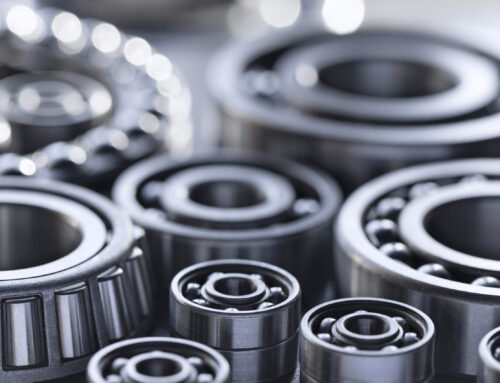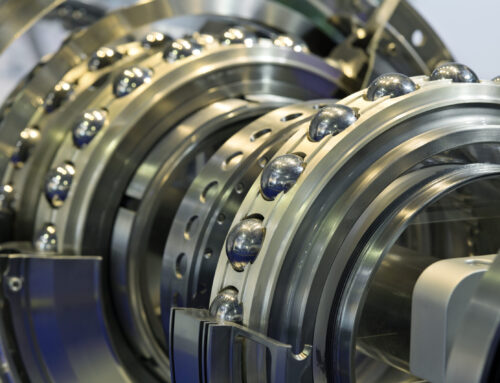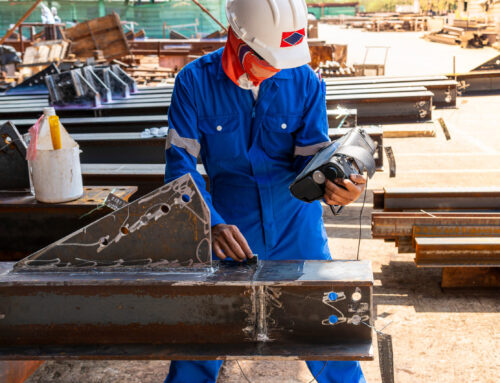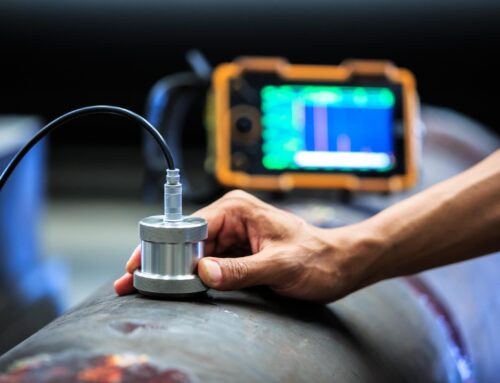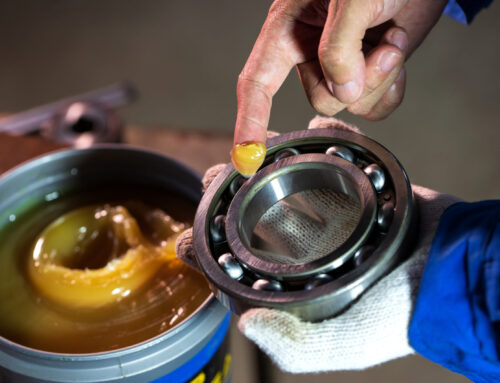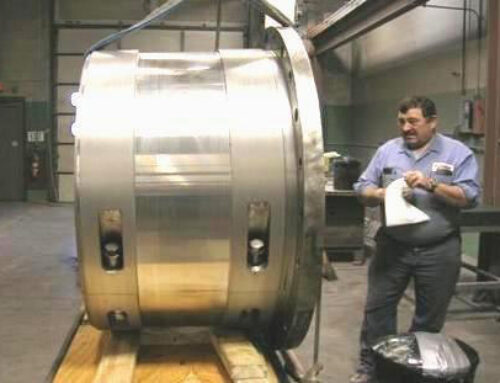
Why the tin vs lead babbitt decision matters
When you are repairing or manufacturing hydrodynamic bearings, the babbitt alloy you choose sets the tone for service life, efficiency, and cost. ASTM B23 is the standard specification for babbitt bearing alloys used in industrial equipment. Within that standard, alloys fall broadly into two families: tin-base and lead-base. Each family contains multiple grades with different hardness and fatigue strength. The best choice depends on the bearing’s load, speed, and operating temperature, along with oil quality and start-stop behavior. This guide explains tin vs lead babbitt in practical terms, so you can specify the right ASTM B23 grade with confidence.
Fusion Babbitting has helped plants across the United States make the right alloy selection since 1988. Our engineering and production teams see how alloys behave in the real world, from electric motors and turbines to pumps and hydro units. The insights below combine proven metallurgical facts with field experience to help you choose and succeed.
Tin vs lead babbitt at a glance
Strengths of tin-base babbitt
- Higher fatigue strength for heavier loads and high PV conditions
- Better resistance to elevated oil temperatures
- Improved corrosion resistance in moist or acidic environments
- Excellent conformability and embeddability for hydrodynamic films
- Preferred for high speed, critical-duty, and long-life applications
Strengths of lead-base babbitt
- Lower material cost for budget-sensitive projects
- Good performance at moderate loads and speeds
- Suitable for large, slow-speed bearings with generous clearances
- Often adequate when oil is clean and operating temperature is modest
- A practical choice for noncritical or legacy equipment
Limitations to consider
- Tin-base babbitt: Higher cost and can be too hard for some slow, misaligned shafts unless clearances are correct.
- Lead-base babbitt: Lower fatigue strength and temperature capability. Greater risk of fatigue cracking or wipe in high PV or poor lubrication.
In short, tin-base excels when conditions are demanding. Lead-base can be the smart, economical choice when service conditions are moderate and controlled. The next sections break this down by load, speed, and temperature to fit the way you specify bearings.
How ASTM B23 grades align with load, speed, and temperature
Load: static, dynamic, and shock considerations
In a plain bearing, load appears as pressure on the babbitt surface. High unit load and shock loading elevate fatigue stress. If your equipment carries heavy radial or thrust loads, or sees frequent starts and stops, tin-base ASTM B23 grades typically provide the safety margin you want.
- High and variable loads: Choose a tin-base grade with higher fatigue strength. These grades resist crack initiation at the bond line and within the babbitt matrix.
- Moderate loads with steady operation: A lead-base ASTM B23 grade can perform reliably, especially when supported by good oil film formation and proper alignment.
- Shock loads or misalignment: Even with lead-base, success depends on geometry. Fusion Babbitting can optimize oil groove layout, fillet radii, and journal finish to protect the babbitt from edge loading.
Speed: surface velocity and oil film stability
Bearing speed appears as surface velocity at the journal. Higher speed increases heat generation and magnifies the consequences of any oil starvation. Tin-base alloys maintain their strength better at elevated temperatures produced by high speed, which is why they are preferred in turbines, high RPM motors, and multistage pumps.
- High speed or frequent speed swings: Favor tin-base grades. Their higher fatigue resistance and stability support a robust hydrodynamic film at narrow clearances.
- Slow to moderate speed with thick oil films: Lead-base grades are often adequate, particularly in large industrial gearboxes, crushers, or mills where speed is low and oil flow is ample.
- Start-stop service: If you start and stop often, choose tin-base or upgrade oil supply systems to reduce boundary contact during acceleration and coast-down.
Temperature: continuous oil temperature and hot spots
Babbitt alloys soften as temperature rises. Tin-base babbitt typically tolerates higher steady-state oil temperatures and intermittent hot spots better than lead-base. If your sump or supply oil temperature runs high, or your duty cycle trends hot, tin-base is usually the safer choice.
- Elevated continuous oil temperature: Select a tin-base ASTM B23 grade to maintain margin against softening, creep, and wipe.
- Moderate or cool oil temperature: Lead-base grades are acceptable and cost effective, provided ventilation and oil flow remain stable.
- Dirty or water-contaminated oil: Both families are sensitive to contamination, but tin-base offers better corrosion resistance. Improving filtration is essential regardless of alloy.
Translating operating conditions into alloy selection
Many specifiers use a combined measure of bearing pressure and velocity, often referred to as PV. As PV and temperature rise, tin-base babbitt becomes the go-to choice. At lower PV and controlled temperatures, lead-base is viable. The following scenarios show how this plays out, using common equipment that Fusion Babbitting services every day.
Electric motors and generators
These bearings run at moderate to high speed with tight clearances and steady loads. Failures often trace back to misalignment, oil issues, or electrical fluting. Tin-base ASTM B23 grades are generally preferred for their fatigue margin and temperature stability. If your motor is small, runs cool, and has excellent oil control, a lead-base grade can be considered, but most plants standardize on tin-base for reliability.
Pumps and hydro units
Pumps span a wide range of duties. High speed, multistage pump bearings benefit from tin-base babbitt because of higher PV and potential transient temperature spikes. In hydro power systems where speed is lower but loads can be heavy and shock events occur, tin-base still offers valuable fatigue resistance. Lead-base can work in auxiliary pumps or older, slow-speed units with conservative loadings and clean oil.
Steam and gas turbines
Turbines demand tin-base babbitt. High surface speeds, elevated oil temperatures, and long service intervals favor tin-base ASTM B23 grades with robust fatigue behavior. Selecting a lead-base alloy in these conditions increases the risk of fatigue cracking and wipe during upset conditions or trips.
Gearboxes, crushers, and mills
These operate at low to moderate speeds with thick oil films. Lead-base babbitt can be acceptable and economical when alignment is good and oil cleanliness is maintained. If shock loads, temperature rise, or contamination is a concern, upgrading to tin-base improves durability with minimal impact on maintenance practices.
Marine propulsion and shipyard applications
Marine bearings face stop-start cycles, vibration, and exposure to moisture. Tin-base offers better corrosion resistance and fatigue performance, which helps during docking maneuvers and load changes. Lead-base may be considered for auxiliary machinery with moderate duty and well-managed lubrication.
ASTM B23 grades explained in simple terms
ASTM B23 groups babbitt into tin-base and lead-base families. Within each family, grades vary by hardness and the relative amounts of alloying elements such as antimony and copper. As antimony and copper increase, hardness and fatigue strength rise, but conformability can drop slightly. Practical selection comes down to balancing strength, embeddability, and the realities of your lubrication system.
Tin-base grades
These alloys center on tin with controlled antimony and copper to form a strong matrix with hard intermetallic crystals. Key benefits include stable performance at higher temperature, superior fatigue resistance, and consistent bond integrity when cast correctly. Within the tin-base family, select higher strength grades for high PV and slightly softer grades for moderate PV where extra conformability is desired.
Lead-base grades
Lead-base babbitt delivers a soft, embeddable matrix at lower cost. Added antimony and tin provide strength and structure, but overall fatigue capability and hot strength remain below tin-base. Choose lead-base grades for moderate PV, cool oil, and large bearing envelopes where inexpensive, easily serviceable materials are desirable.
The role of antimony and copper
Antimony and copper influence hardness and fatigue. More antimony and copper lean toward higher strength and better resistance to cracking under load. They also reduce the alloy’s tendency to smear under boundary conditions. This is valuable in high PV service, but only when alignment, journal finish, and oil supply are well controlled. Fusion Babbitting can guide you to the best balance for your specific bearing geometry and duty cycle.
Avoiding common failure modes with the right alloy
Fatigue cracking
Fatigue shows up as fine cracks at the bond line or in the babbitt face, often progressing to spalling. If you see repeated fatigue failures, a tin-base upgrade and improved casting process are recommended. Fusion Babbitting employs centrifugal casting that enhances bond strength and uniformity, improving resistance to fatigue.
Seizure and wipe
Seizure occurs when boundary contact overheats the surface. A higher strength tin-base grade withstands brief boundary contact better, but root causes still need attention. Check for oil starvation, clogged grooves, or poor shaft finish. In lower PV service, a softer grade with good embeddability can protect against transient debris until filtration is corrected.
Corrosion and erosion
Water ingress, acidic vapors, or fine abrasive particles attack the babbitt. Tin-base babbitt resists corrosion better than lead-base. Regardless of alloy, fix the source by improving seals, upgrading filtration, or adjusting oil chemistry.
Embeddability and conformability
Babbitt alloys should absorb tiny particles and conform slightly under load to protect the journal. Both tin-base and lead-base provide these traits, though very high strength grades can be less forgiving if alignment is poor. Timely relubrication and precise machining are essential to get full benefit from your alloy choice.
How Fusion Babbitting supports the right choice
Fusion Babbitting Co., Inc., based in Milwaukee, WI, is a trusted partner for babbitt bearing repair, rebabbitting, rebuilding, and new manufacture. Since 1988, we have delivered bearings that meet or exceed OEM specifications for demanding industries such as aluminum mills, cement and chemical plants, fossil and nuclear power, hydro and pump storage, marine repair, mines and steel mills, motor repair shops, paper mills, shipyards, and crushed stone producers.
Our capabilities include centrifugal casting for strong bond integrity, arc flame spray for restoring worn components, reverse engineering of obsolete bearings with detailed drawings, and general fabrication and machining for components up to 120 inches in diameter and length. Whether you operate electric motors, hydro power systems, pumps, or turbines, our specialists match ASTM B23 tin-base or lead-base grades to your actual duty cycle. We also provide 24-hour emergency service when downtime costs cannot be tolerated.
Every project begins with a practical review of load, speed, and temperature, as well as alignment, oil supply, and surface finish. With over 40 years of combined expertise, Fusion Babbitting engineers specify the right alloy, casting method, and machining tolerances so your equipment runs efficiently and reliably.
When to upgrade and when to stay with lead-base
Upgrade to tin-base when your bearings suffer recurring fatigue, operate at higher oil temperatures, or run at high surface speeds. If you are increasing machine throughput, upgrading an oil system, or tightening clearances for efficiency, tin-base typically supports those changes better.
Stay with lead-base when loads, speeds, and temperatures are clearly moderate, you maintain clean oil, and cost is a priority. Large, slow-speed bearings with generous film thickness can run for years on the correct lead-base grade, especially after a quality rebabbitt with precise machining.
Quick selection checklist for tin vs lead babbitt
- List operating load conditions, including startup, steady-state, and any shock events.
- Calculate or estimate surface speed and confirm the expected oil film thickness.
- Record oil supply and sump temperatures across seasons and duty cycles.
- Assess oil cleanliness, water ingress risk, and filtration capability.
- Review shaft finish, bearing alignment, and groove geometry.
- Consider downtime cost and desired maintenance interval.
- Match an ASTM B23 tin-base or lead-base grade to the PV and temperature picture.
- Verify casting and machining plans with your bearing supplier.
- Monitor performance after installation and adjust alloy or clearances as needed.
Frequently asked questions
Is tin-base babbitt always better than lead-base?
No. Tin-base is stronger and more temperature tolerant, but lead-base can be the right choice for lower PV, cool oil, and budget-driven repairs. Success depends on a good match to your real operating conditions.
Can I switch from lead-base to tin-base during a rebuild?
Yes, in many cases. Verify that shaft finish, housing geometry, and oil delivery are appropriate for the higher strength grade. Fusion Babbitting can review your application and recommend any adjustments needed for a smooth upgrade.
What is the biggest cause of babbitt failure?
Lubrication problems lead the list. Oil starvation, contamination, and thermal run-up drive fatigue and wipe. Alloy choice matters, but oil management and alignment are just as important.
How do I know which ASTM B23 grade to specify?
Start with whether your duty trends toward high PV and elevated temperature. If yes, choose a tin-base grade. If not, a lead-base grade may be adequate. When in doubt, contact Fusion Babbitting for a detailed review and a written recommendation.
Partner with Fusion Babbitting for confident alloy selection
Selecting tin vs lead babbitt under ASTM B23 is straightforward when you focus on load, speed, and temperature. Tin-base grades are best for high PV, higher oil temperatures, and critical uptime. Lead-base grades work for moderate service where cost control matters and lubrication is well managed. The safest way to decide is to review your data with a specialist who understands both metallurgy and field performance.
Fusion Babbitting is ready to help you specify the right ASTM B23 grade, restore bond integrity with centrifugal casting, reverse engineer obsolete parts, or manufacture new bearings for OEM projects. Reach us at 414.645.5800 or toll-free at 800.613.5118, or email sales@fusionbabbitting.com. You can also visit us at 4540 W. Burnham St., Milwaukee, WI 53219. With 24-hour emergency service and nationwide coverage, Fusion Babbitting delivers reliable bearings that keep your machinery running strong.
If you are evaluating a repair, planning an upgrade, or writing a new specification, connect with Fusion Babbitting today. Get a clear, application-driven recommendation for tin vs lead babbitt, along with a fast, high-quality repair or new manufacture that meets or exceeds OEM expectations

